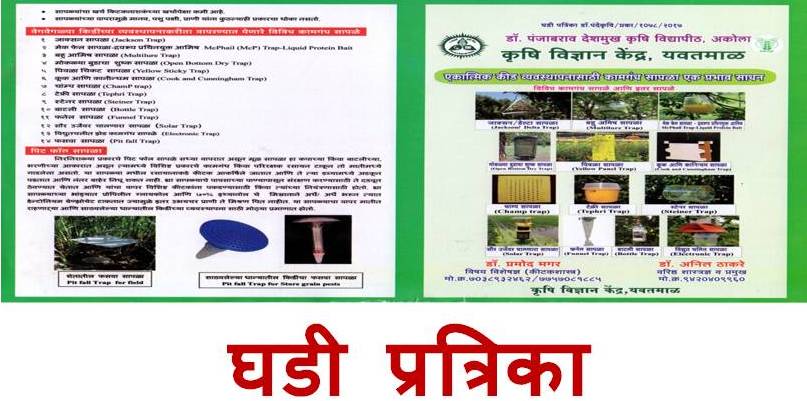Preamble
The Yavatmal district of Central Vidarbha Zone of Maharashtra State is located between 20.39925” of North Latitude while 78.11792” of Eastern Longitude. The major area of the district is located in the Southern Plateau of Berar. It is surrounded by Amravati districts in the North, Akola and Parbhani districts in the West, Nanded and Adilabad districts in the South and Chandrapur and Wardha districts in the East.
The district comes under assured rainfall area of VIIIthAgroclimatic Zone with average annual rainfall of 1050 mm mostly received during June to September months from the north -eastern monsoon rains.
The soils of the district are 50% light (7.5 – 25 cm i.e. Entisol), 30% medium (26-50 cm i.e. Inceptisol) and 20% black cotton soils (91 – 100 cm i.e. Vertisol).
Agricultural and allied census
| Geographical area | 13,51,966 hectare |
| Cultivable area | 9,60,500 hectare |
| Area under Forest | 2,03,147 hectare |
| Area under Kharif Crop | 9,05,000 hectare |
| Area under Rabi Crop | 87,000 hectare |
| Area under Summer Crop | 7,000 hectare |
| Rainfed Area | 8,37,946 hectare (7 to 8 % irrigated) |
| Total Number of farmers | 4,17,402 |
| Marginal (Less than 1.00 ha) | 28,640 (6.86 %) |
| Small (1.00 to 2.00 ha) | 1,61,227 (38.63 %) |
| Large (More than 2.00 ha) | 2,27,535 (54.51 %) |
| Total Taluka’s | 16 |
| Minimum temp | 9.4 0C |
| Maximum temp | 47 0C |
| Average Rain fall (June to Dec.) | 911.03 mm |
| Average number of rainy days | 56 |
Major Crops
| Kharif | Cotton, Sorghum, Soybean, Tur,Green gram, Black gram |
| Rabi /Summer | Wheat, Chickpea, Rabi Sorghum Summer Groundnut, Sugar cane (Annual) |
| Horticultural crops | Oranges, Sweet Oranges, Banana, Custard apple |
Soil Type
| Light soil | 4,42,100 hectare (45.98 %) |
| Medium soil | 2,20,800hectare (23 %) |
| Heavy soil | 2,97,600hectare (31.02 %) |
OTHER INFORMATION:
AGRO-CLIMATIC ZONES
The district Yavatmal falls under Agro-climatic Zone No. 8 i.e. Moderate Rainfall Zone. Only small western part of Darwaha & Ner Tahsils falls under assured rainfall zone No. 7. The Average rainfall received in this Zone usually exceeds 900 m. m. The climate is hot and dry. More than 75% rainfall in this zone is received in Kharifseason, hence Kharif cropping system Predominates in the zone. In general, all types of soils are observed in this zone. Preferably, medium and heavy in texture, fairly high in clay content, alkaline in reaction, high lime reserve with high base saturation of the exchange complex. The soils are severely eroded & shallow. They are uneven in depth and are uncertain by stony substrata. They are intercepted by gullies having rapid run off resulting in severe erosion & prone to drought ness.
Agro Ecological Situations (AES) Of Yavatmal District
| Agro Ecological Situations | Characteristics | Blocks Covered |
| I | Medium to heavy soils, rainfed area | Wani, Maregaon, ZariJamni |
| II | Light to medium soils, command area and well irrigation | Umarkhed, Pusad, Digras, Mahagaon |
| III | Mostly Rainfed Medium to heavy soils, Surrounded by forest. | Pandharkawada, Ghatanji, Arni |
| IV | Light to heavy soils, irrigation through wells, Horticulture crop pocket | Yavatmal, Kalamb, Ralegaon |
| V | Mostly rainfed light to Medium soils | Ner, Darwha, Babhulgaon |
Major and Micro-Farming Systems:
| Soil type | Characteristics | Area in ha |
| Shallow | Very dark brown clay, blocky, slightly hard, crack visible, disintegrated murum | 50 % |
| Deep | Dark brown clay, cloddy, hard, lime nodules present thought the profile, Disintegrated murum | 30 % |
| Very deep | Very dark brown clay,cloddy, hard,full of lime concretion concretionincresing with depth | 20 % |
Major Farming Situation:
| SN | Farming Situation | Cropping System exists |
| 1 | Medium to heavy soils, rainfed area | Cotton – fallow, Soybean – Gram, Jower – Wheat – fallows |
| 2 | Light to medium soils, command area and well irrigation | Citrus – vegetable (Intercrop) Cotton – fallow Red gram – fellow Soybean – Bengal gram |
| 3 | Mostly Rainfed Medium to heavy soils, Surrounded by forest. | Soybean – fallow Cotton – fallow Soybean – Bengal gram |
| 4 | Light to heavy soils, irrigation through wells, Horticulture crop pocket | Citrus – Vegetable (Intercrop) Cotton – Fallow Soybean- Fallow |
| 5 | Mostly rainfed light to Medium soils | Cotton – fallow Soybean – Bengal gram Soybean – Wheat |
Major farming systems/enterprises (based on the analysis made by the KVK)
| Major farming system | Micro Farming systems |
| Agriculture crops | Agri + Horti + Dairy |
| Rainfed Cotton | Agri + Dairy |
| Rainfed Soybean | Agri + Goat farming |
| Rainfed Jawar | Agri + Sericulture |
| Irrigated Wheat | Agri + Horticulture |
| Irrigated Gram | Agri. + Horti. + Poultry |
| Irrigated Summer Groundnut, Sesamum, Rabi Jawar | |
| Major Inter cropping systems | Major production systems |
| Cotton + Tur (8:1) (12:2) | Cotton – Gram
Cotton – Wheat Soybean – Wheat Soybean – Gram Soybean – Rabi Jawar Soybean – Summer Groundnut |
| Soybean + Tur (10:1)(5:1) | Hy. Jawar – Wheat
HyJawar – Gram Turmeric |
Description of Agro-climatic Zone & major agro ecological situations (based on soil and topography):
| Agro-climatic Zone | Characteristics |
| Agro-climatic Zone No.8 | Moderate Rainfall Zone. Only small western part of Darwha&NerTahsils falls under assured rainfall zone No. 7. The Average rainfall received in this Zone usually exceeds 900 m. m. The climate is hot and dry. More than 75% rainfall in this zone is received in Kharif season; hence Kharif cropping system predominates in the zone. In general, all types of soils are observed in this zone. Preferably, medium and heavy in texture, fairly high in clay content, alkaline in reaction, high lime reserve with high base saturation of the exchange complex. The soils are severely eroded & shallow. They are uneven in depth and are undertain by stony substrata. They are intercepted by gullies having rapid run off resulting in severe erosion & prone to doughtiness. |
Major Agricultural and allied enterprises
| S. N. | Type of enterprises/commodities |
| 1 | Agricultural crops : Irrigated Cotton, Rainfed cotton, Sorghum, Pigeonpea, Soybean, Wheat, Chickpea, Sugarcane, |
| 2 | Horticulture crops : Orchards, Vegetable, Floriculture, Turmeric ,Chilly |
| 3 | Animal husbandry : Cows, Buffalos, sheep, Goat, Pigs |
| 4 | Fisheries |
| 5 | Sericulture |
| 6 | Poultry |
| 7 | Agriculture labour |
| 8 | Bee Keeping |
| 9 | Vermi –compost |
| 10 | Mushroom production |
| 11 | Value addition by processing of Pigeon pea , Vegetable , Soybean |









